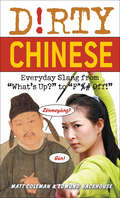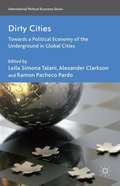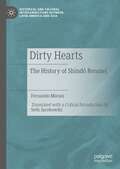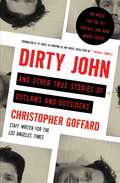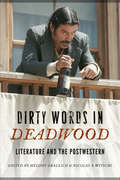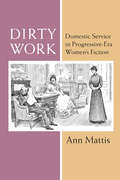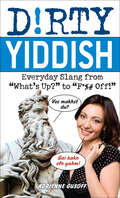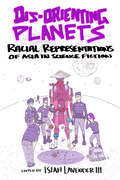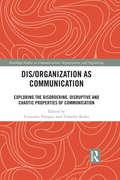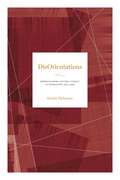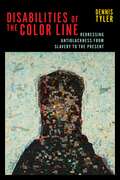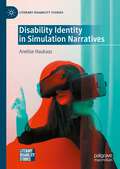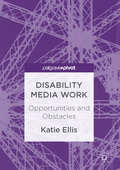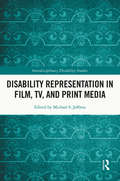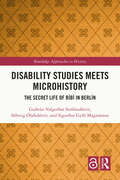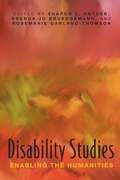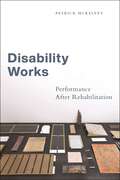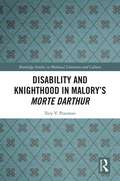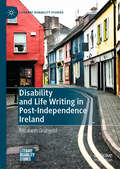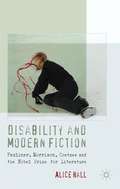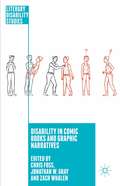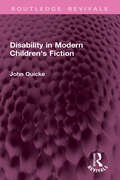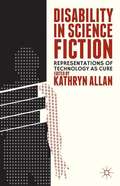- Table View
- List View
Dirty Chinese: Everyday Slang from "What's Up?" to "F*%# Off!" (Dirty Everyday Slang)
by Matt Coleman Edmund BackhouseFoul your mouth—while expanding your Mandarin vocabulary—with a guide to the phrases that could get you a laugh . . . or a punch in the face.Next time you’re traveling or just chattin’ in Chinese with your friends, drop the textbook formality and bust out with expressions they never teach you in school, including:Cool slangFunny insultsExplicit sex termsRaw swear wordsDirty Chinese teaches the casual expressions heard every day on the streets of China:What’s up? Zenmeyàng?Fuck it, let’s party. Qù tama, zánmen chuqù feng ba.Who farted? Shéi fàng de pì?Wanna try doggy-style? Yàobù zánliar shìshì gou cào shì?Son of a bitch! Gouniángyang de!I’m getting smashed. Wo ganjué heduo le.I can’t eat this shit! Wo chi bù xià qù!
Dirty Cities
by Alexander Clarkson Leila Simona Talani Ramon Pacheco PardoOver the last three decades, the rapid growth of transport and telecommunications systems and the expansion of transnational diasporas have intensified links between the urban spaces of Europe, Africa, the Middle East and Southeast Asia. Increasing global mobility has fostered the development of 'informal' trading networks in which diaspora communities play a central role. As a consequence, the shadow economies of societies with vastly different levels of prosperity have begun to come into contact with one another. While the economic consequences of diaspora trading networks have been extensively explored over the past few decades, the impact of globalization on the economic underground has received much less attention. This volume elaborates on the definition of globalization, on its impact on illegal and illicit activities, and on the role of the 'Global City' as the intersection between the local and the global which allows for the empowerment of generally marginalized actors often through technological progress. The contributors explore the dark side of globalization, more specifically, the relations between globalization and the new dynamics of legal/illegal practices in urban settings of global cities.
Dirty Hearts: The History of Shindō Renmei (Historical and Cultural Interconnections between Latin America and Asia)
by Fernando MoraisFernando Morais’ Dirty Hearts is a tour de force of literary journalism that investigates the discriminatory treatment of the Japanese immigrant community in Brazil during World War II and in the aftermath of Japan’s defeat and unconditional surrender. In contrast to the internment camps and compulsory military service that characterized the Japanese American wartime experience, this book traces the rise to power of Shindō Renmei, an ultranationalist secret society that formed in response to the anti-Japanese measures enacted under Getulio Vargas’ Estado Novo. Based in São Paulo, the group used terrorism, propaganda campaigns, and conspiracy theories to violently enforce its narrative of Japan’s victory. These traumatic events nevertheless brought about a permanent transformation in the Japanese Brazilian community from a largely insular colony with close ties to its imperial homeland to its new identity as an ethnic minority in postwar Brazil’s fraught racial democracy.
Dirty John and Other True Stories of Outlaws and Outsiders
by Christopher GoffardA collection of newspaper stories by award-winning Los Angeles Times reporter Christopher Goffard—including &“Dirty John,&” the basis for the hit podcast and the upcoming Bravo scripted series starring Connie Britton and Eric Bana.Since its release in fall 2017, the &“Dirty John&” podcast—about a conman who terrorizes a Southern California family—has been downloaded more than 20 million times, and will soon premiere as a scripted drama on Bravo starring Connie Britton and Eric Bana. The story, which also ran as a print series in the Los Angeles Times, wasn&’t unfamiliar terrain to its writer, Christopher Goffard. Over two decades at newspapers from Florida to California, Goffard has reported probingly on the shadowy, unseen corners of society. This book gathers together for the first time &“Dirty John&” and the rest of his very best work. &“The $40 Lawyer&” provides an inside account of a young public defender&’s rookie year in the legal trenches. &“Framed&” offers an unblinking chronicle of suburban mayhem (and is currently being developed by Netflix as a film starring Julia Roberts). A man wrongly imprisoned for rape, train-riding runaways in love, a Syrian mother forced to leave her children in order to save them, a boy who grows up to become a cop as a way of honoring his murdered sister, another boy who struggles with the knowledge that his father is on death row: these stories reveal the complexities of human nature, showing people at both their most courageous and their most flawed. Goffard shared in the Los Angeles Times&’ Pulitzer Prize for Public Service in 2011 and has twice been a Pulitzer finalist for feature writing. This collection—a must-read for fans of both true-crime and first-rate narrative nonfiction—underscores his reputation as one of today&’s most original journalistic voices.
Dirty Sign Language: Everyday Slang from "What's Up?" to "F*%# Off!" (Dirty Everyday Slang Ser.)
by Evan Wondolowki Allison O Van James TGET D!RTY!Next time you're signing with your friends, drop the ASL textbook formality and start flashing the signs they don't teach in any classroom, including: cool slang funny insults explicit sex terms raw swear wordsDirty Sign Language teaches casual everyday words and expressions like: Peace out! Asshole. Bit me! Dumbfuck! Boner I'm hung like a horse.
Dirty Words in Deadwood: Literature and the Postwestern (Postwestern Horizons)
by Nicolas S. Witschi Melody GraulichDirty Words in &“Deadwood&” showcases literary analyses of the Deadwood television series by leading western American literary critics. Whereas previous reaction to the series has largely addressed the question of historical accuracy rather than intertextuality or literary complexity, Melody Graulich and Nicolas S. Witschi&’s edited volume brings a much-needed perspective to Deadwood&’s representation of the frontier West.As Graulich observes in her introduction: &“With its emotional coherence, compelling characterizations, compressed structural brilliance, moral ambiguity, language experiments, interpretation of the past, relevance to the present, and engagement with its literary forebears, Deadwood is an aesthetic triumph as historical fiction and, like much great literature, makes a case for the humanistic value of storytelling.&” From previously unpublished interviews with series creator David Milch to explorations of sexuality, disability, cinematic technique, and western narrative, this collection focuses on Deadwood as a series ultimately about the imagination, as a verbal and visual construct, and as a literary masterpiece that richly rewards close analysis and interpretation.
Dirty Work: Domestic Service in Progressive-Era Women’s Fiction (Class : Culture)
by Ann MattisDirty Work sheds light on the complex relationships between women employers and their household help in the early twentieth century through their representations in literature, including women’s magazines, conduct manuals, and particularly female-authored fiction. Domestic service brought together women from different classes, races, and ethnicities, and with it, a degree of social anxiety as upwardly mobile young women struggled to construct their identities in a changing world. The book focuses on the works of Charlotte Perkins Gilman, Edith Wharton, Gertrude Stein, Nella Larsen, Jessie Fauset, Anzia Yezierska, and Fannie Hurst and their various depictions of the maid/mistress relationship, revealing “a feminized and racialized brand of class hegemony.” Modern servants became configured as racial, hygienic, and social threats to the emergent ideal of the nuclear family, and played critical rhetorical roles in first-wave feminism and the New Negro movements. Ann Mattis reveals how U.S. domestic service was the political unconscious of cultural narratives that attempted to define modern domesticity and progressive femininity in monolithic terms.
Dirty Yiddish: Everyday Slang from "What's Up?" to "F*%# Off!" (Dirty Everyday Slang)
by Adrienne GusoffNext time you’re chattin’ with your khaverim (friends) and mishpukheh (family), bust out some Yiddish expressions that’ll liven up the conversation.Nothing is censored in Dirty Yiddish. It includes phrases for any situation, so readers have enough chutzpah (balls) to tell the local deli that they’ve waited long enough for their knish, and explicit swear words crude enough to shock Bubby and everyone else at the Passover seder. There’s even vulgar sex terminology so graphic it puts the outspoken Lower East Side princesses to shame. Bust out with expressions they never teach you in school, including cool slang, funny insults, explicit sex terms, and raw swear words. Dirty Yiddish teaches the casual expressions heard every day on the streets of New York . . . What’s up? Vos makhst du?Crazy bastard! Meshuggeneh momzer!I’m hammered. Ikh bin fershikkert.Don’t fuck with me! Bareh mikh nit!I have the shits. Ikh hob a shittern mogn.Lick my pussy. Lekh meyn lokh.Was it good for you? Tsufreedn?
Dis-Orienting Planets: Racial Representations of Asia in Science Fiction
by Isiah Lavender IIIContributions by Suparno Banerjee, Cait Coker, Jeshua Enriquez, Joan Gordon, Veronica Hollinger, Malisa Kurtz, Stephanie Li, Bradford Lyau, Uppinder Mehan, Graham J. Murphy, Baryon Tensor Posadas, Amy J. Ransom, Robin Anne Reid, Haerin Shin, Stephen Hong Sohn, Takayuki Tatsumi, and Timothy J. Yamamura Isiah Lavender III's Dis-Orienting Planets amplifies critical issues surrounding the racial and ethnic dimensions of science fiction. This edited volume explores depictions of Asia and Asians in science fiction literature, film, and fandom with particular regard to China, Japan, India, and Korea. Dis-Orienting Planets highlights so-called yellow and brown peoples from the constellation of a historically white genre. The collection launches into political representations of Asian identity in science fiction's imagination, from fear of the Yellow Peril and its racist stereotypes to techno-Orientalism and the remains of a postcolonial heritage. Thus the essays, by contributors such as Takayuki Tatsumi, Veronica Hollinger, Uppinder Mehan, and Stephen Hong Sohn, reconfigure the very study of race in science fiction. A follow-up to Lavender's Black and Brown Planets, this collection expands the racial politics governing the renewed visibility of Asia in science fiction. One of the few on this subject, the volume probes Gary Shteyngart's novel Super Sad True Love Story, the acclaimed film Cloud Atlas, and Guillermo del Toro's monster film Pacific Rim, among others. Dis-Orienting Planets embarks on a wide-ranging assessment of Asian representations in science fiction, upon the determination that our visions of the future must include all people of color.
Dis/organization as Communication: Exploring the Disordering, Disruptive and Chaotic Properties of Communication (Routledge Studies in Communication, Organization, and Organizing)
by Consuelo Vásquez Timothy KuhnThis book accounts for the transformation of organizations in a post-bureaucratic era by bringing a communicational lens to the ontological discussion on organization/disorganization, offering a conceptual and methodological toolbox for studying dis/organization as communication. Increasingly, scholars acknowledge that communication is constitutive of organization; because meaning is always indeterminate, communication also (and simultaneously) generates disorganization. The book synthesizes the major theoretical trends and empirical studies in communication that engage with dis/organization. Drawing on dialectics, relational ontologies, critical theory, systems theory, and affect thinking, the first part of the book offers communicational explanations of how dis/organization unfolds. The second part of the book grounds this theoretical reflection, providing empirical studies that mobilize diverse methodological and analytical frameworks (e.g., ethnography, situational, interactional and genre analysis) for studying the practices of dis/organization. Overall, the book exposes organizations (and organizing processes) as significantly messier, irrational (or a-rational), and paradoxical than scholars of organization typically think. It also offers readers the conceptual and methodological tools to understand these complex processes as communication. This book will be essential reading for scholars in organizational communication or management and organization studies, together with senior undergraduate and graduate students studying organizational communication, organizational discourse, discourse analysis (including rhetoric, semiotics, pragmatism, narratology) and courses in management studies. It will also be richly rewarding for organizational consultants, managers and executives.
DisOrientations: German-Turkish Cultural Contact in Translation, 1811-1946 (Max Kade Research Institute)
by Kristin DickinsonThe fields of comparative and world literature tend to have a unidirectional, Eurocentric focus, with attention to concepts of “origin” and “arrival.” DisOrientations challenges this viewpoint. Kristin Dickinson employs a unique multilingual archive of German and Turkish translated texts from the early nineteenth through the mid-twentieth century. In this analysis, she reveals the omnidirectional and transtemporal movements of translations, which, she argues, harbor the disorienting potential to reconfigure the relationships of original to translation, past to present, and West to East. Through the work of three key figures—Johann Wolfgang von Goethe, Friedrich Schrader, and Sabahattin Ali—Dickinson develops a concept of translational orientation as a mode of omnidirectional encounter. She sheds light on translations that are not bound by the terms of economic imperialism, Orientalism, or Westernization, focusing on case studies that work against the basic premises of containment and originality that undergird Orientalism’s system of discursive knowledge production. By linking literary traditions across retroactively applied periodizations, the translations examined in this book act as points of connection that produce new directionalities and open new configurations of a future German-Turkish relationship.Groundbreaking and erudite, DisOrientations examines literary translation as a complex mode of cultural, political, and linguistic orientation. This book will appeal to scholars and students of translation theory, comparative literature, Orientalism, and the history of German-Turkish cultural relations.
DisOrientations: German-Turkish Cultural Contact in Translation, 1811-1946 (Max Kade Research Institute: Germans Beyond Europe #15)
by Kristin DickinsonThe fields of comparative and world literature tend to have a unidirectional, Eurocentric focus, with attention to concepts of "origin" and "arrival." DisOrientations challenges this viewpoint. Kristin Dickinson employs a unique multilingual archive of German and Turkish translated texts from the early nineteenth through the mid-twentieth century. In this analysis, she reveals the omnidirectional and transtemporal movements of translations, which, she argues, harbor the disorienting potential to reconfigure the relationships of original to translation, past to present, and West to East. Through the work of three key figures—Johann Wolfgang von Goethe, Friedrich Schrader, and Sabahattin Ali—Dickinson develops a concept of translational orientation as a mode of omnidirectional encounter. She sheds light on translations that are not bound by the terms of economic imperialism, Orientalism, or Westernization, focusing on case studies that work against the basic premises of containment and originality that undergird Orientalism’s system of discursive knowledge production. By linking literary traditions across retroactively applied periodizations, the translations examined in this book act as points of connection that produce new directionalities and open new configurations of a future German-Turkish relationship.Groundbreaking and erudite, DisOrientations examines literary translation as a complex mode of cultural, political, and linguistic orientation. This book will appeal to scholars and students of translation theory, comparative literature, Orientalism, and the history of German-Turkish cultural relations.
Disabilities of the Color Line: Redressing Antiblackness from Slavery to the Present (Crip #5)
by Dennis TylerWinner of the 2023 Phi Beta Kappa Christian Gauss AwardHonorable Mention for the 2022 Robert K. Martin Book Prize from the Canadian Association for American Studies (CAAS)ASALH 2023 Book Prize FinalistReveals how disability and disablement have shaped Black social life in AmericaThrough both law and custom, the color line has cast Black people as innately disabled and thus unfit for freedom, incapable of self-governance, and contagious within the national body politic. Disabilities of the Color Line maintains that the Black literary tradition historically has inverted this casting by exposing the disablement of racism without disclaiming disability.In place of a triumphalist narrative of overcoming where both disability and disablement alike are shunned, Dennis Tyler argues that Black authors and activists have consistently avowed what he calls the disabilities of the color line: the historical and ongoing anti-Black systems of division that maim, immobilize, and stigmatize Black people. In doing so, Tyler reveals how Black writers and activists such as David Walker, Henry Box Brown, William and Ellen Craft, Charles Chesnutt, James Weldon Johnson, and Mamie Till-Mobley have engaged in a politics and aesthetics of redress: modes of resistance that, in the pursuit of racial and disability justice, acknowledged the disabling violence perpetrated by anti-Black regimes in order to conceive or engender dynamic new worlds that account for people of all abilities. While some writers have affirmed disability to capture how their bodies, minds, and health have been made vulnerable to harm and impairment by the state and its citizens, others’ assertion of disability symbolizes a sense of community as well as a willingness to imagine and create a world distinct from the dominant social order.
Disability Identity in Simulation Narratives (Literary Disability Studies)
by Anelise HaukaasDisability Identity in Simulation Narratives considers the relationship between disability identity and simulation activities (ranging from traditional gameplay to more revolutionary technology) in contemporary science fiction. Anelise Haukaas applies posthumanist theory to an examination of disability identity in a variety of science fiction texts: adult novels, young adult literature and comics, as well as ethnographic research with gamers. Haukaas argues that instead of being a means of escapism, simulated experiences are a valuable tool for cultivating self-acceptance and promoting empathy. Through increasingly accessible technology and innovative gameplay, traditional hierarchies are dismantled, and different ways of being are both explored and validated. Ultimately, the book aims to expand our understandings of disability, performance, and self-creation in significant ways by exploring the boundless selves that the simulated environments in these texts allow.
Disability Media Work
by Katie EllisThis book interrogates trends in training and employment of people with disabilities in the media through an analysis of people with disabilities' self-representation in media employment. Improving disability representations in the media is vital to improving the social position of people with disability, and including people with lived experience of disability is integral to this process. While the media industry has changed significantly as a result of digital and participatory media, discriminatory attitudes around fear and pity continue to impact whether people with disability find work in the media. The book demonstrates no significant changes in attitudes towards employing disabled media workers since the 1990s when the last major research into this topic took place. By focusing on the employment of people with disability in media industries, Katie Ellis addresses a neglected area of media diversity, appealing to researchers in media and cultural studies as well as critical disability studies.
Disability Representation in Film, TV, and Print Media (Interdisciplinary Disability Studies)
by Michael S. JeffressUsing sources from a wide variety of print and digital media, this book discusses the need for ample and healthy portrayals of disability and neurodiversity in the media, as the primary way that most people learn about conditions. It contains 13 newly written chapters drawing on representations of disability in popular culture from film, television, and print media in both the Global North and the Global South, including the United States, Canada, India, and Kenya. Although disability is often framed using a limited range of stereotypical tropes such as victims, supercrips, or suffering patients, this book shows how disability and neurodiversity are making their way into more mainstream media productions and publications with movies, television shows, and books featuring prominent and even lead characters with disabilities or neurodiversity. Disability Representation in Film, TV, and Print Media will be of interest to all scholars and students of disability studies, cultural studies, film studies, gender studies, and sociology more broadly.
Disability Studies Meets Microhistory: The Secret Life of Bíbí in Berlín (ISSN)
by Sigurður Gylfi Magnússon Guðrún Valgerður Stefánsdóttir Sólveig ÓlafsdóttirThis volume explores the life of Bjargey “Bíbí” Kristjánsdóttir (1927–1999), an Icelandic woman with intellectual disabilities, through analysis of her autobiography and personal archive on the basis of the research disciplines of critical disability studies and microhistory.Bíbí, who grew up in northern Iceland on a small farm called Berlin, fell ill when she was in her first year and was afterward labeled "feeble-minded" by her family and the local community. When Bíbí died, she had finished a 145,000-word autobiography which she had written alone and kept secret from her family and neighbors, very few of whom even knew that she could read and write. This book aims to consider Bíbí’s life through her autobiography and other historical sources she created, to identify how various historical, social, and cultural factors interacted and influenced her circumstances. It explores Bíbí’s agency, and how she managed to play her cards within the narrow scope given to her by society. What makes Bíbí’s history extraordinary is precisely the direct connection to her world through her counter-archive.This book provides students and scholars of the humanities and the social sciences with a new way of critical thinking about both disciplines.
Disability Studies: Enabling the Humanities
by Brenda Jo Brueggemann Sharon L. Snyder Rosemarie Garland-ThomsonImages of disability pervade language and literature, yet disability is, as the volume's introduction notes, "the ubiquitous unspoken topic in contemporary culture." The twenty-five essays in Disability Studies provide perspectives on disabled people and on disability in the humanities, art, the media, medicine, psychology, the academy, and society.Edited and introduced by Sharon L. Snyder, Brenda Jo Brueggemann, and Rosemarie Garland-Thomson and containing an afterword by Michael Bérubé (author of Life As We Know It), the volume is rich in its cast of characters (including John Bulwer, Teresa de Cartagena, Audre Lorde, Oliver Sacks, Samuel Johnson, Mark Twain, Walt Whitman); in its powerful, authentic accounts of disabled conditions (deafness, blindness, MS, cancer, the absence of limbs); in its different settings (ancient Greece, medieval Spain, Nazi Germany, the modern United States); and in its mix of the intellectual and the emotional, of subtle theory and plainspoken autobiography.
Disability Works: Performance After Rehabilitation (Performance and American Cultures #8)
by Patrick McKelveyA cultural history of disability, performance, and work in the modern United StatesIn 1967, the US government funded the National Theatre of the Deaf, a groundbreaking rehabilitation initiative employing deaf actors. This project aligned with the postwar belief that transforming bodies, minds, aesthetics, and institutions could liberate disabled Americans from economic reliance on the state, and demonstrated the growing optimism that performance could provide job opportunities for people with disabilities.Disability Works offers an original cultural history of disability and performance in modern America, exploring rehabilitation’s competing legacies. The book highlights an unexpected alliance of rehabilitation professionals, deaf teachers, policy makers, disability activists, queer artists, and religious leaders who championed performance’s rehabilitative potential. At the same time, some disabled artists imagined a different political itinerary for theatrical practice. Rather than acquiescing to the terms of productive citizenship, these artists recuperated rehabilitation as a creative resource for imagining and building a world beyond work. Using previously unexplored archives, Disability Works portrays the history of disabled Americans’ performance labor as both a national aspiration and a national problem. The book reveals how disabled artists and activists ingeniously used rehabilitative resources to fuel their performance practices, breaking free from the grasp of rehabilitation and fostering more just institutions.From state-funded “sign-mime” to Black modern dance, community theatre to Stanislavskian actor training, speculative activism to epistolary performance, Disability Works recovers an expansive repertoire of aesthetic and infrastructural investigations into the terms of how disability works in modern American culture.
Disability and Knighthood in Malory’s Morte Darthur
by Tory PearmanThis book considers the representation of disability and knighthood in Malory’s Morte Darthur. The study asserts that Malory’s unique definition of knighthood, which emphasizes the unstable nature of the knight’s physical body and the body of chivalry to which he belongs, depends upon disability. As a result, a knight must perpetually oscillate between disability and ability in order to maintain his status. The knights’ movement between disability and ability is also essential to the project of Malory’s book, as well as its narrative structure, as it reflects the text’s fixation on and alternation between the wholeness and fragmentation of physical and social bodies. Disability in its many forms undergirds the book, helping to cohere the text’s multiple and sometimes disparate chapters into the "hoole book" that Malory envisions. The Morte, thus, construes disability as an as an ambiguous, even liminal state that threatens even as it shores up the cohesive notion of knighthood the text endorses.
Disability and Life Writing in Post-Independence Ireland (Literary Disability Studies)
by Elizabeth GrubgeldThis book is the first to examine life writing and disability in the context of Irish culture. It will be valuable to readers interested in Disability Studies, Irish Studies, autobiography and life writing, working-class literature, popular culture, and new media. Ranging from Sean O’Casey’s 1939 childhood memoir to contemporary blogging practices, Disability and Life Writing in Post-Independence Ireland analyzes a century of autobiographical writing about the social, psychological, economic, and physical dimensions of living with disabilities. The book examines memoirs of sight loss with reference to class and labor conditions, the harrowing stories of residential institutions and the advent of the independent living movement, and the autobiographical fiction of such acknowledged literary figures as Christy Brown and playwright Stewart Parker. Extending the discussion to the contemporary moment, popular genres such as the sports and celebrity autobiography are explored, as well as such newer phenomena as blogging and self-referential performance art.
Disability and Modern Fiction
by Alice HallDisability and Modern Fiction explores shifting definitions and representations of physical and mental impairment in 20th and 21st century culture through a focus on the work of William Faulkner, Toni Morrison and JM Coetzee. Taking as its starting point Virginia Woolf's essay 'On Being Ill' (1930), the book argues that focusing on literary representations of disability opens up new critical categories for the analysis of fiction. Through consideration of their work as critics and Nobel Prize-winning public intellectuals, as well as authors, the book proposes new ways of reading Faulkner, Morrison and Coetzee in relation to one another, and in doing so highlights the ethical, aesthetic and imaginative challenges they pose to readers.
Disability in Comic Books and Graphic Narratives (Literary Disability Studies)
by Zach WhalenAs there has yet to be any substantial scrutiny of the complex confluences a more sustained dialogue between disability studies and comics studies might suggest, Disability in Comic Books and Graphic Narratives aims through its broad range of approaches and focus points to explore this exciting subject in productive and provocative ways.
Disability in Modern Children's Fiction (Routledge Revivals)
by John QuickeFirst published in 1985, Disability in Modern Children’s Fiction presents a case for the inclusion of a planned element in the mainstream curriculum, specifically designed to encourage positive attitudes and actions towards children with special needs, and for utilising the possibilities inherent in fiction for helping all children to explore their thoughts and feelings in this area. The central chapters of the book are concerned with a critical examination of specific texts, focusing on how they deal with disability in a story context. Books are grouped for discussion under common themes which have been teased out according to their contemporary relevance: the effects on the family of a severely disabled child; the struggle of a child with a disability for personal identity in oppressive social circumstances; the interaction between disability, race, gender and social class; the different reactions of ‘normal’ children towards disabled peers; the failings of the medical approach to disability; love, sex, adolescence and disability; the relationship between children and handicapped adults. The penultimate chapter is concerned with an evaluation of picture books and quasi-fiction for younger children. This book will be of interest to students of disability studies, pedagogy and literature.
Disability in Science Fiction
by Kathryn AllanIn this groundbreaking collection, twelve international scholars - with backgrounds in disability studies, English and world literature, classics, and history - discuss the representation of dis/ability, medical "cures," technology, and the body in science fiction.
